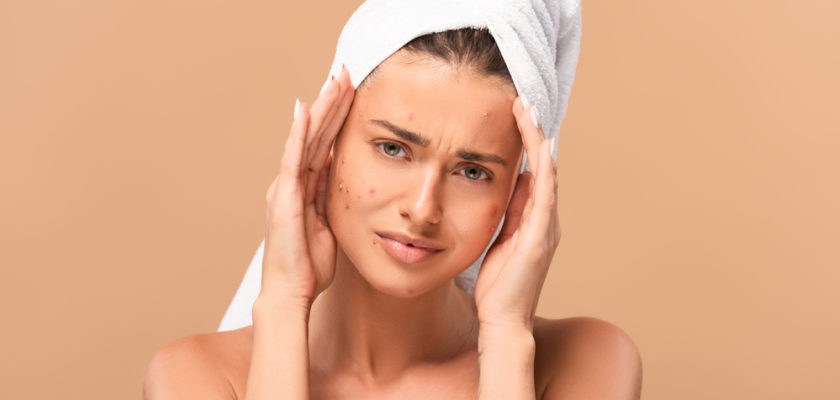Taking care of your skin is one of the basics of maintaining a healthy lifestyle. While many foods are recommended as part of a nutritional plan to keep your skin clean and safe, it’s also critical to know what to avoid in order to achieve the optimum result and get the look you seek. If you’re prone to acne, avoid these 6 foods like the plague!
Fast Food
While it’s kind of a no-brainer to avoid fast food regardless of who you are, those who are prone to acne have it the worse as numerous studies have shown that increases the risk of developing acne.
One study was conducted with 2,300 Turkish men, and it showed that eating sausages and burgers frequently was associated with a 24% increase of developing acne.
As we all know, fast food is notorious for having a surplus of fat and refined carbohydrates and being rich in calories. Among such fast foods are French fries, burgers, sodas, milkshakes, and nuggets to mention a few examples.
While a link between fast food consumption and the risk of developing acne has been clearly established, the exact reasons as to why it might be are still unclear. However, some researchers have speculated that the reason behind it might be the fact that fast food affects genes and changes hormone levels in a way such as to stimulate acne development[1].
With all that said, it’s important to mention that the majority of the studies done on fast food have mainly included self-reported data, which doesn’t necessarily prove that fast food directly causes acne due to the fact that it only shows patterns of dietary habits and acne risk.
Sugar
Nowadays, sugar is such a widespread commodity that it’s quite rare to find something that doesn’t have sugar in it. This is quite problematic as it makes it easier to lose track of how much sugar one is consuming and can easily lead to an excess amount of sugar consumption.
The reason this is so problematic is the fact that overeating sugar has a plethora of nefarious effects on the human body. Eating a lot of sugar can cause inflammation in your skin and body along with making your skin oily and more prone to developing acne[2]. You should always keep natural sugar (which is found in fruits and vegetables) consumption to moderate levels and consume as little refined sugars (which are found in sweets, sodas, cakes…) as possible.
Another essential thing to keep in mind is that foods that are advertised as having low-sugar are usually high in fats while foods that are supposedly low on fats have rich in sugar, so try and stay away from those.
Chocolate
While we’re on the subject of sweets, let’s also talk about chocolate. Whether or not chocolate is associated with an increased risk of acne development is not a recent debate. In fact, it has been brought up since the 1920s, yet no conclusive evidence was found to establish that link[3].
There are numerous surveys and studies done that show a link between chocolate consumption and acne development.
One study, for example, showed that men who took 100% cocoa powder capsules on a daily basis had a lot more acne lesions one week later when compared to those who got a placebo[4].
Another study also found that males who are prone to acne, when consuming 25 grams of 99% dark chocolate per day, had an increased risk of acne lesions after just two weeks[5].
It’s still unclear why chocolate increases acne. However, a study showed that eating chocolate stimulated the immune system making it react more aggressively to acne-causing bacteria hence the increased risk of acne.
Dairy Products
Some people have reported that dairy products such as milk, buttermilk, yogurt, cheese, ice cream… could cause skin blemishes. If you have any blemishes, try consuming fewer dairy products and see if this has any effect.
It’s best to just go for dairy-free products as they’re the safer choice when it comes to this subject. When it comes to whole or skimmed milk, research has found that skimmed milk is more comedogenic than whole milk. With that said, it’s just better to go for alternatives that are dairy-free, like almond or coconut milk. However, stay away from powdered milk or rice milk.
Another thing to keep in mind is that some foods have dairy products as an ingredient so always be aware of what exactly you’re eating.
Inflammatory Fats
Fat is made up of building blocks, as described by the Harvard Health Publications site. These fatty acids can be categorized into three types: Monosaturated, polyunsaturated, or saturated. The latter type is the most harmful of the three.
The NHS advises against consuming a high amount of saturated fats as they can increase the level of cholesterol in your blood, hence increasing the risk of heart disease. Not only that, but saturated fats also increase skin inflammation thus causing a higher risk of acne development and can also cause our skin to have an oily texture to it.
Saturated fats can be found in red meats, like lamb, beef, bacon. Other foods that contain a lot of saturated fats are cakes, pastries in general, pies, cream, pizza, cheese, and butter.
It’s also recommended that you stay away from food that contains a lot of oil as that can also cause your skin to become oily in texture. Examples of such foods are doughnuts, chips and deep-fried foods in general.
Alcohol
Technically speaking, alcohol is not a food type, but when consumed, it can have a nefarious effect on your skin especially if you’re prone to having oily skin.
Alcohol is known to dehydrate. When your skin isn’t properly hydrated, it resorts to forming oil to compensate for the lack of water which is the leading cause of breakouts.
On top of that, alcohol causes sweatiness and can cause you to eat fatty foods which all leads to your skin pores being clogged which is never a good thing.
References
- [1] https://www.ncbi.nlm.nih.gov/pubmed/23614736
- [2] https://www.ncbi.nlm.nih.gov/pubmed/28606553
- [3] https://www.ncbi.nlm.nih.gov/pubmed/23438493
- [4] https://www.ncbi.nlm.nih.gov/pubmed/24847404
- [5] https://www.ncbi.nlm.nih.gov/pubmed/26711092

